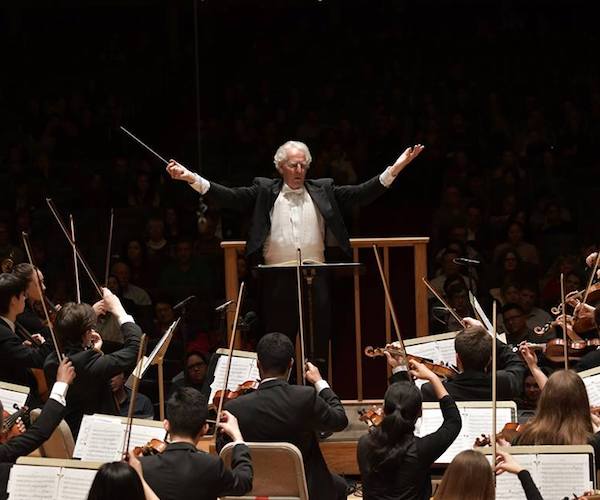Concert Review: Boston Philharmonic Youth Orchestra plays Britten, Schwantner, and Holst
By Jonathan Blumhofer
This Sunday’s BPYO concert tied together a number of highly personal strands, presenting music connected to two of conductor Benjamin Zander’s mentors — Benjamin Britten and Gustav Holst.

Benjamin Zander conducting the Boston Philharmonic Youth Orchestra. Photo: courtesy of the BPYO.
Benjamin Zander’s 80th birthday celebration this season has, so far, resulted in some fine and, last weekend, revelatory performances by his Boston Philharmonic and Boston Philharmonic Youth Orchestra (BPYO). This Sunday’s BPYO concert continued the trend, though it also tied together a number of highly personal strands, presenting music connected to two of Zander’s mentors — Benjamin Britten and Gustav Holst (his theory teacher was Holst’s daughter, Imogen) — along with a major work by Joseph Schwantner.
Britten’s The Young Person’s Guide to the Orchestra is both a showpiece and a succinct, meaningful educational effort — which means it fits Zander the conductor and teacher to a “T.” Written for a 1946 film, the Guide takes a theme from Henry Purcell’s incidental music to the play Abdelazer as its departure point, treating it to a series of variations showcasing each of the orchestra’s primary instruments and families before concluding with a brilliant fugal finale.
Sunday’s reading was well-balanced and energetic. The variation for oboes sang warmly, the one for violins soared, and that for basses was spunky and characterful. Harps shimmered, brasses were burnished and fleet, the percussion taut. If a few of the smaller details might have benefited from sharper definition, well, the big picture came across blazingly and the closing fugue — taken at a bold clip — was thrilling: perfectly balanced, spirited, and, once the theme rolled around for its final iteration, emotionally cathartic.
Thomas Juhasz, a 14-year-old BPYO oboist, turned in a fine, straightforward account of the narration.
Another piece for speaker followed the Britten. That was New Morning for the World, “Daybreak of Freedom,” Schwantner’s 1983 meditation on texts by Dr. Martin Luther King, Jr. Scored for narrator and a large orchestra, it traffics in two main types of music: the first, seething and martial; the second, hymn-like and reflective. Throughout its near-half-hour duration these two kinds of music alternate, with subtle variations ensuring that the repetition of materials doesn’t wear thin. The ending is quiet, laden with nervous expectation.
For the Schwantner, Sunday’s chronicler was none other than former Massachusetts Governor Deval Patrick. A stirring orator in his own right, it took him a little while to settle in to Morning’s spoken part (which was perhaps the result of his being slightly over-amplified). Regardless, the Governor ultimately delivered a charismatic account of King’s writings, his clarion tenor proving, in its own way, as compelling as King’s righteous baritone.
Zander drew a tightly focused reading of the piece from the BPYO. Slashing fanfares and percussive riffs set the tone at the beginning, while the contrasting lyrical sections sang radiantly. Throughout, Schwantner’s penchant for luminous sonorities — this is a wildly active piece, especially for the percussion — shined brightly.
Any work for speaker and orchestra, especially one on a political theme, will draw comparison with Copland’s Lincoln Portrait. New Morning for the World is cut from a similar cloth as the older work but ends up going its own way, like the Copland walking the tightrope between bombast and sentimentality. It’s a stirring piece — and a timely one — in all the right ways. The BPYO and its esteemed guest did the music, and its subject, proud.
They also made impressive work of Gustav Holst’s The Planets. This immensely popular musical depiction of the solar system is in every serious orchestra’s wheelhouse; the BPYO’s no exception.
Their account of the piece ranged from a demoniac account of “Mars” (replete with raw, bristling climaxes) to a serene, lush “Venus”; a droll, mischievous “Uranus”; and a beguilingly hazy “Neptune.” In between came a limber “Mercury”; a brawny, athletic “Jupiter”; and a mysterious, but lustrous, “Saturn.”
Plenty of discreet detailing stood out. Concertmaster Mitsuru Yonezaki’s solos in “Venus” were sweetly calibrated. Francis Fang’s realization of “Mercury’s” celesta part spoke brilliantly. Holst’s harp writing in the later movements – particularly the delicate harmonics near the end of “Saturn” and “Uranus” — were as precisely done as can be. And the ladies of the Radcliffe Choral Society proved themselves ringing sirens in “Neptune,” their long fadeout at the end one of the afternoon’s most striking moments.
In a charming note at the beginning of Sunday’s program, Zander recounted (among other things) how his theory lessons with Imogen Holst emphasized the dancing impetus that ultimately lies behind music making.
This weekend’s account of her father’s masterpiece demonstrated that those lessons were well-learned: Zander’s take on Planets were light on their feet, brimming with personality, and fully attuned to the music’s native rhythmic qualities.
Jonathan Blumhofer is a composer and violist who has been active in the greater Boston area since 2004. His music has received numerous awards and been performed by various ensembles, including the American Composers Orchestra, Kiev Philharmonic, Camerata Chicago, Xanthos Ensemble, and Juventas New Music Group. Since receiving his doctorate from Boston University in 2010, Jon has taught at Clark University, Worcester Polytechnic Institute, and online for the University of Phoenix, in addition to writing music criticism for the Worcester Telegram & Gazette.
